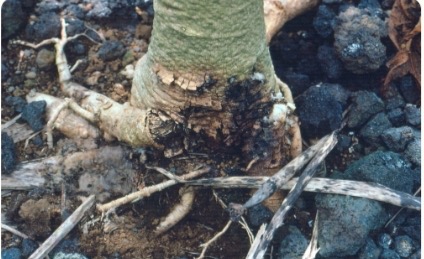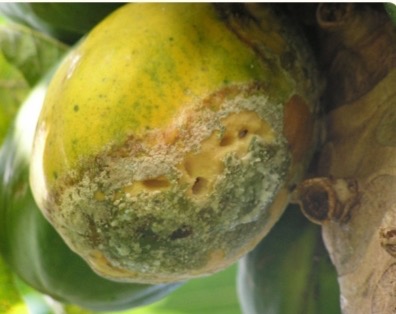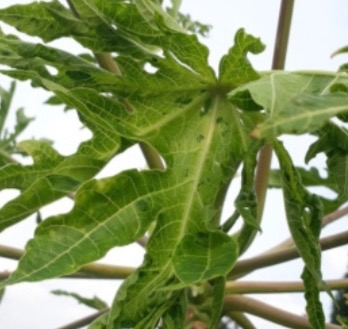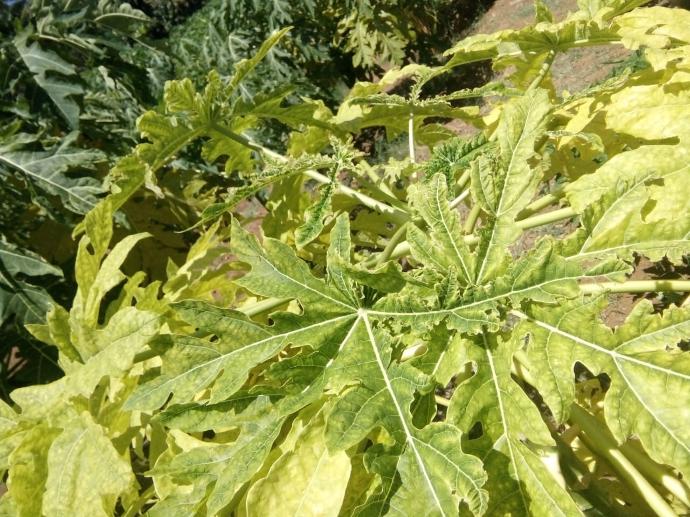Papaya Tree
Papaya trees, with a fast growth rate, prefer well-drained soil and full sun. Hardy in zones 10-12, papayas are valued for their sweet and nutritious fruits.

Habit
Tree
Height
3-6 m
Growth
Fast
Soil
Well-drained, sandy loam
Shade
Full Sun
Moisture
Moderate
Edible
Yes
Medicinal
Yes
Origin
Tropical regions
Climatic Condition
Tropical, Subtropical
Temperature (°)
25-35°C
Humidity (%)
60-80%
Potting media
Loamy, peat
Fertilizers
10:05:20
Watering
Regular, moderate
Plant Weight
10-25 kg
Flowering Time
Year-round
Soil Ph level
5.5 - 6.5
Water Ph level
5.5 - 6.5
Soil EC
1-2 dS/m
Yield Per Plant
1 - 3 kg/plant
NPK ratio
10:05:10
life Span
Perennial
Health Benefits
Rich in vitamins, antioxidants, digestive aid
Suggested Grow Media or Potting Mix ?
50% loamy soil, 30% compost, 20% sand
Suggested Fertigation/Fertilizers
Fertilize every 6 weeks with a balanced, slow-release fertilizer.
Common Diseases and Remedies
Stem rot ,Papaya Mosaic
Leaves turn yellowing and droop off
Spray neem oil , Neem seed kernel extract
HEALTH BENEFITS
· High in vitamin C, boosting immunity.
· Contains papain, aiding digestion and relieving constipation.
· Rich in antioxidants that promote skin health and reduce inflammation.
· Supports heart health by lowering cholesterol levels.
What Is An Papaya Plant ?
A papaya tree, also called Carica papaya, is a tropical fruit tree that bears sweet, juicy, elongated fruits. It has a single trunk, large lobed leaves at the top, and can grow up to 10 meters tall. Native to the Americas, it is now grown in various tropical and subtropical regions globally.
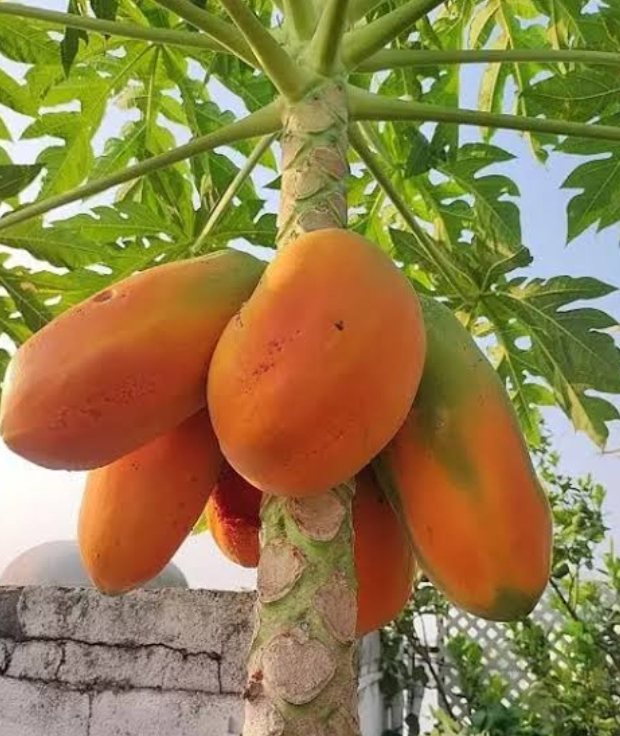
What Are The Different Types Of Papaya Plants?
1. Solo Papaya or Hawaiian
Solo papaya is small to medium-sized with yellow skin and orange flesh.
2. Mexican Papaya
Mexican papaya, also called Caribbean Red, is larger with red-orange flesh and a sweeter taste.
3. Formosa papaya
Formosa papaya is bigger than the other two, with green skin turning yellow-orange when ripe and sweet, aromatic flesh.
4. Caribbean Red Papaya
Similar to the Marador papaya, it has red-orange flesh and is popular in the Caribbean.
5. Marador papaya
Larger than solo papaya, it has red-orange flesh and is often used in salads, salsas, and desserts.

How to care for Papaya Plant ?
Taking care of a papaya plant involves various essential steps: Full sunlight is crucial, with at least 6-8 hours daily needed. Keep the soil moist but not waterlogged, deep watering when the top inch is dry. Balanced fertilizer every 2-3 months during growth season is necessary. Regularly prune dead leaves and unwanted shoots for healthy growth. Support is needed for young or fruit-heavy plants to prevent damage. Be vigilant for pests like aphids and diseases like powdery mildew. Mulch around the base for moisture and nutrients. Protection from frost is necessary in cold climates, consider containers or frost protection. Following these steps ensures a thriving papaya plant and healthy fruit.
1. Location
Papaya plants are usually located in tropical and subtropical areas worldwide, flourishing in warm climates with ample sunlight and well-drained soil. Brazil, India, Indonesia, Nigeria, Mexico, and Thailand are key papaya producers where the plants are commonly cultivated in home gardens, farms, and orchards.
2. Sunshine
Papaya plants thrive in warm, tropical climates with around 6 to 8 hours of direct sunlight daily. They can also tolerate shade, especially in hotter areas where excessive sun exposure could damage the leaves.
3. Soil
The soil needed for papaya plants should be rich in organic matter and well-draining. A combination of sandy loam soil with compost or mature manure is recommended. Papayas thrive in slightly acidic to neutral pH levels of 6.0-7.0. Proper drainage is essential to avoid waterlogging and root rot.
4. Hydration
Adequate hydration is crucial for papaya plants, particularly while they are actively growing. It is important to water the plant consistently to maintain soil moisture without saturating it. Adequate drainage is necessary to avoid root rot from water build-up. In hot weather, more frequent watering may be required. Mulching aids in moisture retention and temperature control. Overwatering should be avoided as it can harm the plant.

5. Nourishment
To care for a papaya plant, ensure it receives proper watering, sunlight, fertilizer, soil, pruning, protection from strong winds, and monitor for pests and diseases to maintain its health and productivity. Fertilizers for papaya plants typically consist of balanced fertilizers with higher potassium, like a 10-10-20 NPK ratio. Organic options such as compost or manure can also benefit papaya growth. The recommended N:P:K ratio for papaya plants is usually around 2:1:3 or 1:1:2, with nitrogen slightly higher than phosphorus and potassium being the highest. For papaya plants, a fertilizer with a ratio of 10-5-20 or 15-15-30 would be appropriate.
6. Issues
Papaya plants can encounter various problems, such as pest invasions, diseases, nutrient deficiencies, watering issues, environmental stress, and soil problems, which can affect their growth and fruit production. Monitoring plant health, providing proper care, and implementing preventive measures are crucial to addressing these issues and promoting healthy papaya plants.
What Are The Benefits of Papaya Plant ?
Benefits of Papaya Plant :
Papaya plants offer multiple benefits such as being rich in vitamins A, C, and E, folate, potassium, and fiber for overall health and immune function.. enzymes like papain promote digestion, antioxidants in papayas improve skin health, compounds in papayas have anti-inflammatory effects, high vitamin C supports the immune system, beta-carotene benefits eye health, fiber, potassium, and antioxidants contribute to heart health. Including papaya in your diet can offer various health benefits and contribute to a healthy lifestyle.

FAQs About Growing Papaya
1. What are the optimal growing conditions for papaya plants?
Papaya plants do well in tropical climates with temperatures ranging from 70°F to 90°F (21°C to 32°C). They thrive in well-drained soil with a pH of 6 to 7 and need 6 to 8 hours of sunlight daily. Regular watering is essential, particularly in dry periods, without waterlogging the soil. Protecting them from strong winds is important due to their shallow roots.
2. What are some common types of papaya plants?
Some popular varieties include: Solo, Red Lady, Maradol , Tainung, Sunrise, Waimanalo, Coorg Honey Dew, and Pusa Delicious.
3. What are the health advantages of eating papayas?
Papayas are abundant in vitamins C and E, along with folate, potassium, and fiber. They also have enzymes such as papain, which assists in digestion, and antioxidants that can decrease inflammation and support overall well-being.
4. What are the typical pests and diseases that papaya plants face?
Papaya plants are vulnerable to a range of pests, like fruit flies, aphids, mealybugs, whiteflies, and spider mites, as well as diseases such as PRSV, PapMV, powdery mildew, black spot, and root rot. Proper management strategies can help control these issues.
5. How can papaya plants be propagated, either through seeds or cuttings?
Propagation from seeds involves collecting and drying ripe seeds before planting them in well-draining soil. For cuttings, healthy stems are selected, cut, and rooted before being planted in soil. Cuttings often lead to quicker fruit production than seeds.
